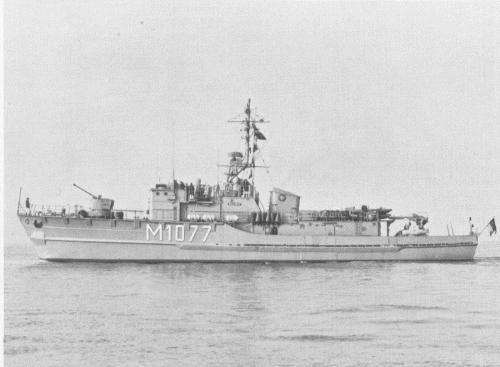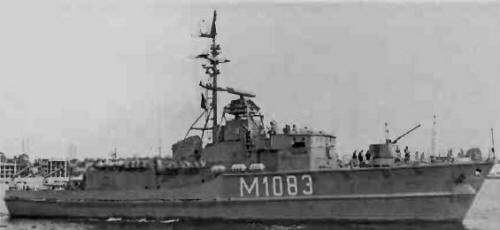
NAVYPEDIA
 Support the project with paypal
Support the project with paypal
Photo

Weilheim 1980
Ships
| Name | No | Yard No | Builder | Laid down | Launched | Comp | Fate |
|---|---|---|---|---|---|---|---|
| Göttingen | M1070 | Burmester Werft, Bremen | 1.4.1957 | 31.5.1958 | minehunter 1.1979, to Latvia 9.1997 | ||
| Koblenz | M1071 | Burmester Werft, Bremen | 6.5.1957 | 8.7.1958 | minehunter 6.1978, to Lithuania 6.1999 (Sūduvis) | ||
| Lindau | M1072 | Burmester Werft, Bremen | 16.2.1957 | 24.4.1958 | minehunter 2.1978, to Estonia 10.2000 (Sulev) | ||
| Schleswig | M1073 | Burmester Werft, Bremen | 2.10.1957 | 30.10.1958 | Troika leader 3.1981, to South Africa 9.2000 (Tshwane) | ||
| Tübingen | M1074 | Burmester Werft, Bremen | 12.8.1957 | 25.9.1958 | minehunter 3.1978, stricken 6.1997 | ||
| Wetzlar | M1075 | Burmester Werft, Bremen | 24.6.1957 | 20.8.1958 | minehunter 10.1978, stricken 6.1995 | ||
| Paderborn | M1076 | Burmester Werft, Bremen | 5.12.1957 | 16.12.1958 | Troika leader 9.1981, to South Africa 6.2000 (Mangaung) | ||
| Weilheim | M1077 | Burmester Werft, Bremen | 4.2.1958 | 28.1.1959 | minehunter 7.1978, stricken 6.1995 | ||
| Cuxhaven | M1078 | Burmester Werft, Bremen | 11.3.1958 | 11.3.1959 | minehunter 6.1979, to Estonia 2.2000 (Wambola) | ||
| Düren | M1079 | Burmester Werft, Bremen | 12.6.1958 | 22.4.1959 | Troika leader 11.1983, to South Africa 9.2000 (Kapa) | ||
| Marburg | M1080 | Burmester Werft, Bremen | 4.8.1958 | 11.6.1959 | minehunter 6.1979, to Lithuania 5.2000 (Kuršis) | ||
| Konstanz | M1081 | Burmester Werft, Bremen | 30.9.1958 | 23.7.1959 | Troika leader 5.1982, to South Africa 9.2000 | ||
| Wolfsburg | M1082 | Burmester Werft, Bremen | 10.12.1958 | 8.10.1959 | Troika leader 3.1982, to South Africa 9.2000 (Tekwini) | ||
| Ulm | M1083 | Burmester Werft, Bremen | 10.2.1959 | 7.11.1959 | Troika leader 11.1981, to South Africa 9.1999 | ||
| Flensburg | M1084 | Burmester Werft, Bremen | 7.4.1959 | 3.12.1959 | minehunter 8.1972, stricken 6.1991 | ||
| Minden | M1085 | Burmester Werft, Bremen | 9.6.1959 | 22.1.1960 | minehunter 5.1978, to Georgia 12.1997 (აეტი [Ayeti]) | ||
| Fulda | M1086 | Burmester Werft, Bremen | 19.8.1959 | 5.3.1960 | minehunter 1969, stricken 3.1992 | ||
| Völkingen | M1087 | Burmester Werft, Bremen | 20.10.1959 | 21.5.1960 | minehunter 5.1979, to Latvia 3.1999 (Namejs) |
Technical data
| Displacement standard, t | 362 |
|---|---|
| Displacement full, t | 380 |
| Length, m | M1070-1075: 42.0 wl 45.0 oa M1076-1087: 42.0 wl 45.6 oa |
| Breadth, m | 8.00 |
| Draught, m | 2.50 |
| No of shafts | 2 |
| Machinery | 2 Maybach MD871 diesels |
| Power, h. p. | 4000 |
| Max speed, kts | 17 |
| Fuel, t | diesel oil 42 |
| Endurance, nm(kts) | 1950(12) |
| Armament | 1 x 1 - 40/70 Bofors 315, 4 DCR, mines, mechanical, acoustic and magnetic minesweeping gear |
| Electronic equipment | TRS-N or Kelvin Hughes 14/9 radar, DSQS-11 sonar |
| Complement | 45 |
Standard scale images

Lindau 1960

Marburg 1980

Schleswig 1979

Konstanz 1990

Lindau 1958
Graphics
Project history
The Type 320 coastal minesweepers were built under the first naval programme and were a German version of the American-designed NATO standard AMS/MSC type. They were built of wood and non-magnetic materials. The first unit, Lindau, was the first ship to be built for the Federal German Navy. After completion of the first six boats it turned out that the extremely high bridge structure affected stability, so the next units were built with one deck less in the bridge; the first boats were modified to the same bridge. Another problem was the stern section, the boats having an upright transom stern, which resulted in insufficient working space on the poop, so the hulls were enlarged by the addition of a stern compartment. During the same refit all boats received a fixed bulwark from bow to stern, the hull plating in the midship section was reinforced, an 18t lead keel and bilge keels were added. Aft of the funnel an ABC proofed space was erected and the original loading derricks abreast the funnel were replaced by cranes.
In 1968-1969 Fulda was converted to a minehunter as was Flensburg in 1970-1972. Instead of the original sonar equipment they received special minehunting sonar Type 193M, the minesweeping equipment was removed ,as mines were now detected and deactivated by scuba-divers. The forecastle superstructure was extended aft. To improve manoeuvrability they were equipped with retractable Schottel-propellers in the transom (in fact, powerful electric outboard motors). This propulsion permits running at extremely slow speeds or manoeuvring on the spot. Between 1976 and 1979 a further ten boats were modified to similar standards with the exception of the Schottel propulsion, in place of which they received a special gearing on the shaft to produce the same manoeuvrability. On the quarterdeck they received a hydraulic telescoping crane and two PAP 104 (Poisson Auto Propulse) working in connection with the minehunting sonar Type 193M. Later, Fulda and Flensburg were also modified to the same standards, but retained their Schottel propulsion. They were distinguished as the Types 331A (Fulda, Flensburg) and 331B (other minehunters).
From 1979 to 1983 the remaining six units were converted to control ships for the 'Troika' system, being designated Type 351. The Troika system consists of a radio control minesweeper of the Type 351 and three self-propelled drones. The drones were of the HFG-F 1 type and were named Seehund 1-18. All eighteen Seehunds formed a pool from which craft were drawn as necessary.
The system was introduced after a year of experiments and trials with Niobe and the prototype drones Walross and Seekuh 1-3.
Modernizations
1958-1959, Göttingen, Koblenz, Lindau, Schleswig, Tübingen, Wetzlar: bridges were lowered as on later ships
1960-1964, all: hulls were lengthened by 2.1m (387/402t, 43.5m wl 47.1m oa)
1969, Fulda; 1972, Flensburg as minehunters Type 331A: - minesweeping gear, DSQS-11 sonar; + diving equipment, type 193M sonar, retractable Schottel propellers in the transom
1978, Koblenz, Lindau, Tübingen, Wetzlar, Weilheim, Minden; 1979, Göttingen, Cuxhaven, Marburg, Völkingen as minehunters Type 331B: - minesweeping gear, DSQS-11 sonar; + 2 PAP-104 minehunting USV, diving equipment, type 193M sonar
1979?, Fulda, Flensburg: + 2 PAP-104 minehunting USV
1981, Schleswig, Paderborn, Ulm; 1982, Konstanz, Wolfsburg; 1983, Düren as 'Troika' leaders type 351 of minesweeping drones: - minesweeping gear; + control equipment for 3 Seehund drone minesweepers
Naval service
No significant events.
 HOME
HOME FIGHTING SHIPS OF THE WORLD
FIGHTING SHIPS OF THE WORLD GERMANY
GERMANY MINE WARFARE SHIPS
MINE WARFARE SHIPS LINDAU coastal minesweepers (1958 - 1960)
LINDAU coastal minesweepers (1958 - 1960)


